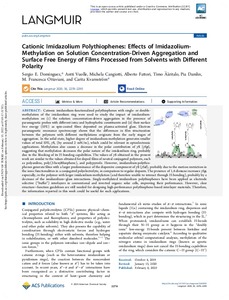Cationic Imidazolium Polythiophenes: Effects of Imidazolium-Methylation on Solution Concentration-Driven Aggregation and Surface Free Energy of Films Processed from Solvents with Different Polarity
Alberto Fattori; Antti Vuolle; Carita Kvarnström; M. Francesca Ottaviani; Michela Cangiotti; Pia Damlin; Sergio E. Dominguez; Timo Ääritalo
Cationic Imidazolium Polythiophenes: Effects of Imidazolium-Methylation on Solution Concentration-Driven Aggregation and Surface Free Energy of Films Processed from Solvents with Different Polarity
Alberto Fattori
Antti Vuolle
Carita Kvarnström
M. Francesca Ottaviani
Michela Cangiotti
Pia Damlin
Sergio E. Dominguez
Timo Ääritalo
AMER CHEMICAL SOC
Julkaisun pysyvä osoite on:
https://urn.fi/URN:NBN:fi-fe2022021519262
https://urn.fi/URN:NBN:fi-fe2022021519262
Tiivistelmä
Cationic imidazolium-functionalized polythiophenes with single- or double-methylation of the imidazolium ring were used to study the impact of imidazolium-methylation on (i) the solution concentration-driven aggregation in the presence of paramagnetic probes with different ionic and hydrophobic constituents and (ii) their surface free energy (SFE) as spin-coated films deposited on plasma-activated glass. Electron paramagnetic resonance spectroscopy shows that the differences in film structuration between the polymers with different methylations originate from the early stages of aggregation. In the solid state, higher degree of imidazolium-methylation generates smaller values of total SFE, gamma S, (by around 2 mN/m), which could be relevant in optoelectronic applications. Methylation also causes a decrease in the polar contribution of gamma S (gamma Sp), suggesting that methylation decreases the polar nature of the imidazolium ring, probably due to the blocking of its H-bonding capabilities. The values of gamma S obtained in the present work are similar to the values obtained for doped films of neutral conjugated polymers, such as polyaniline, poly(3-hexylthiophene), and polypyrrole. However, imidazolium-polythiophenes generate films with a larger predominance of the dispersive component of gamma S (gamma Sd), probably due to the motion restriction in the ionic functionalities in a conjugated polyelectrolyte, in comparison to regular dopants. The presence of 1,4-dioxane increases gamma Sp, especially, in the polymer with larger imidazolium-methylation (and therefore unable to interact through H-bonding), probably by a decrease of the imidazolium-glass interactions. Singly-methylated imidazolium polythiophenes have been applied as electrode selective ("buffer") interlayers in conventional and inverted organic solar cells, improving their performance. However, clear structure-function guidelines are still needed for designing high-performance polythiophene-based interlayer materials. Therefore, the information reported in this work could be useful for such applications.
Kokoelmat
- Rinnakkaistallenteet [19207]
